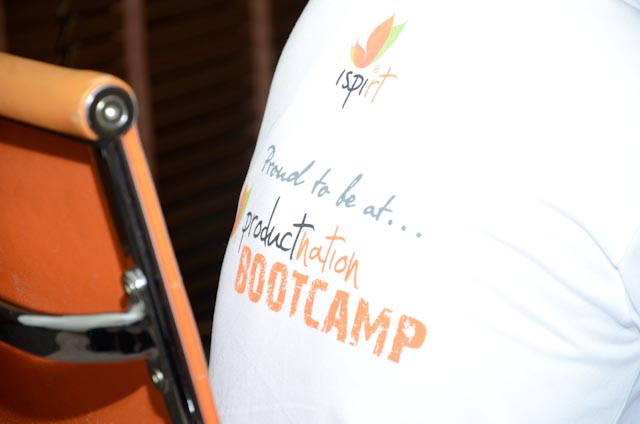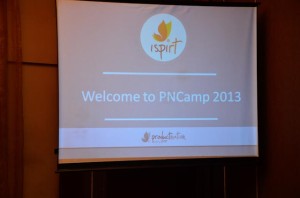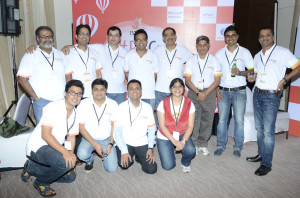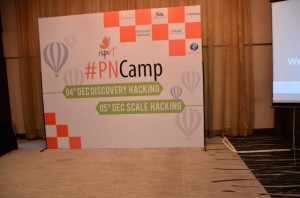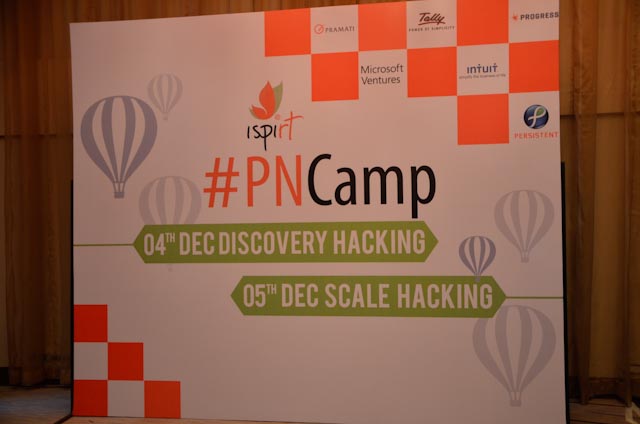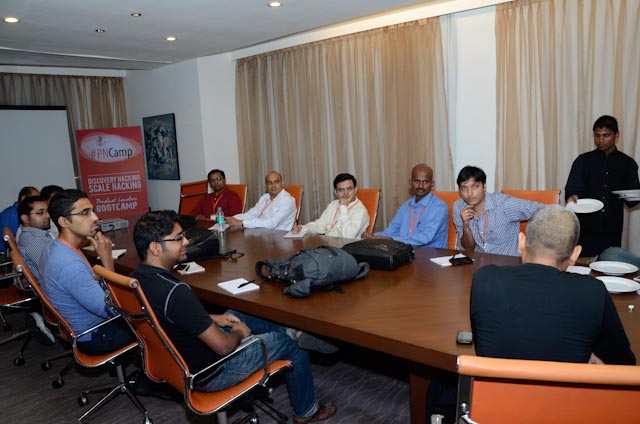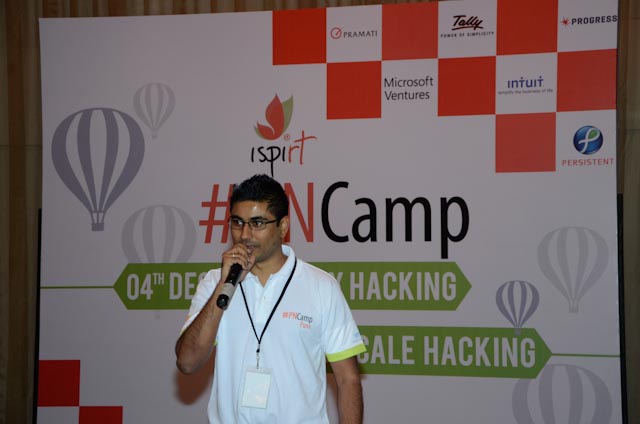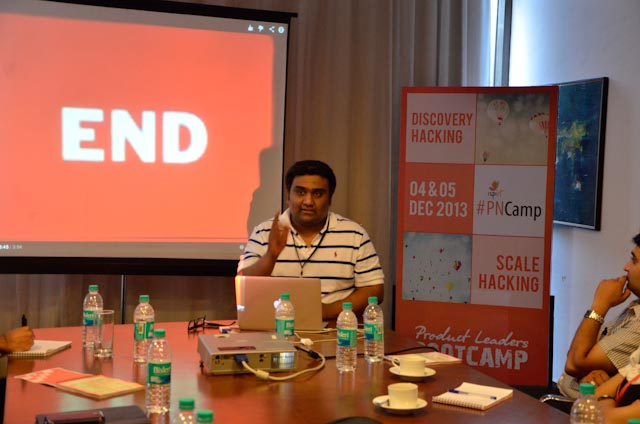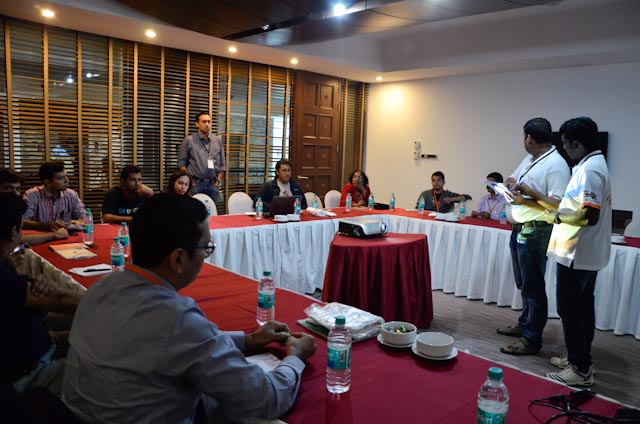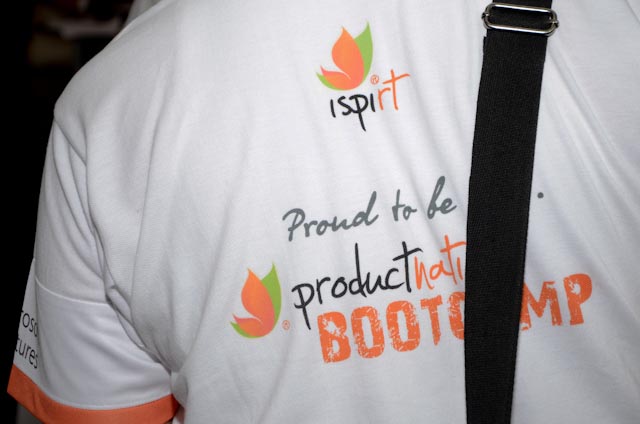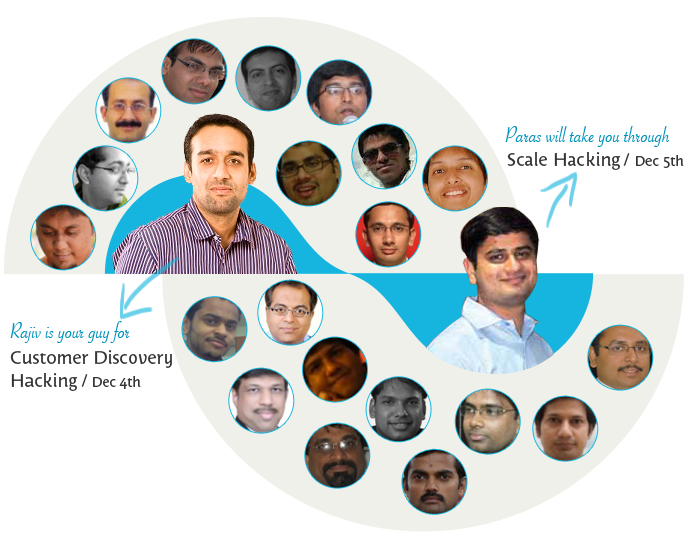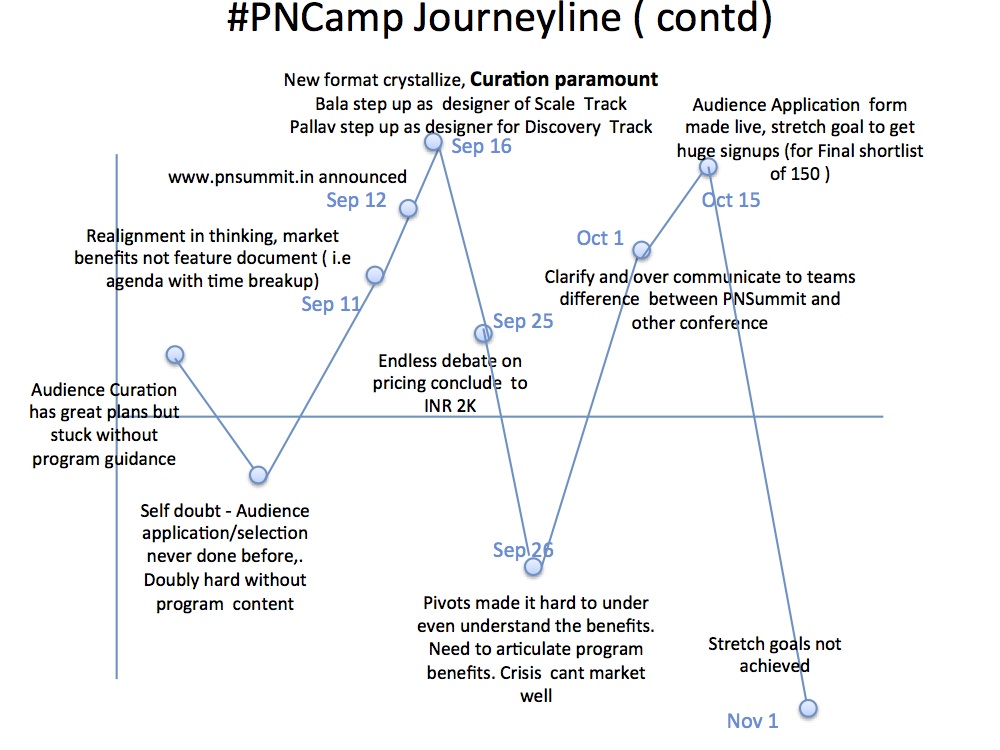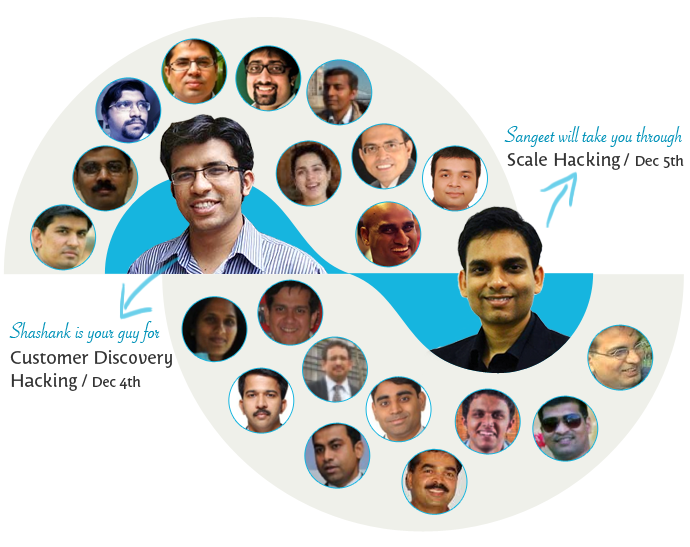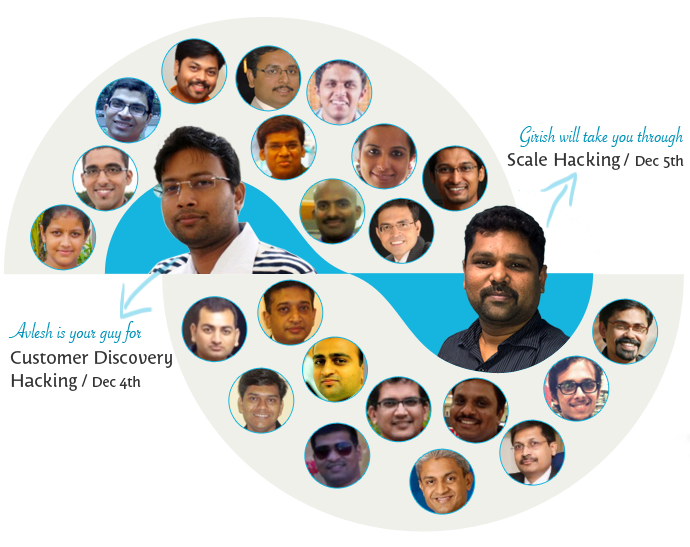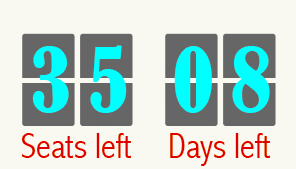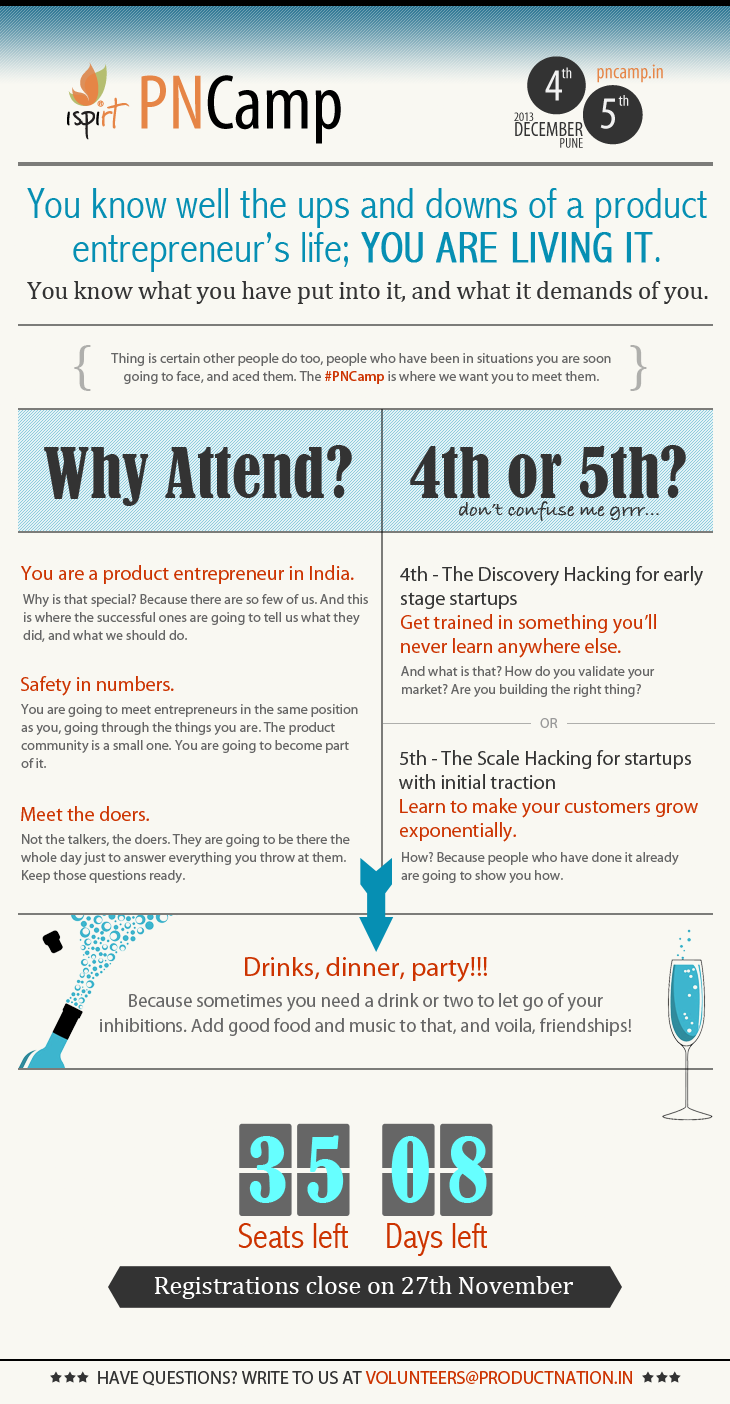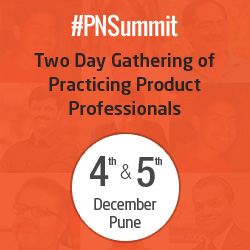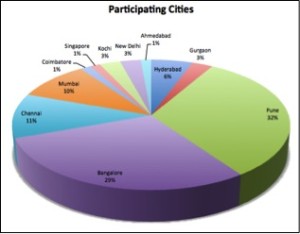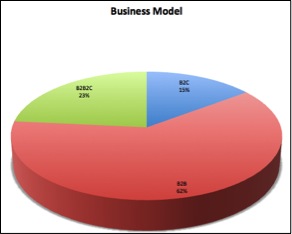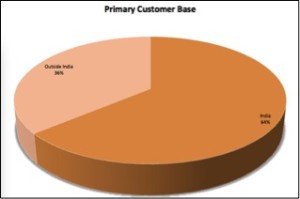The inaugural edition of PNBootcamp at Pune is the best thing to come out from iSPIRT yet – in my opinion. For all the startups that missed this bootcamp, I strongly recommend staying tuned to pn.ispirt.in for the next playbooks and bootcamps.
There were two themes in the bootcamp:
- ‘Discovery Hacking’ for those companies who have not yet figured out the product-market fit.
- ‘Scale Hacking’ for those companies who have figured out the product-market fit and are now looking to build a repeatable and scalable business model.
The participants were divided into cohorts of 15 and these cohorts took part in day long highly interactive discussions facilitated by practitioner entrepreneurs who have ‘been there, done that’. It was very heartwarming to see the ‘pay it forward’ maxim of iSPIRT in full steam. Successful entrepreneurs disseminated their hard-earned learning from their journeys with the intent to improve the product ecosystem in India and ‘let a thousand flowers bloom’. Do visit the PNBootcamp website https://pn.ispirt.in/pncamp/ to look at the illustrious list of facilitators and volunteers.
While trying to figure out how to condense the 50 pages of my notes from the bootcamp into a blog post, I felt that I could do most justice by writing down the top 101 takeaways. Here goes:
Discovery Hacking:
- The most common mistake that startups commit is to build something nobody wants. This is also the largest risk. The most important question to ask is – will my offering remove customers’ pain point? One must first confirm ‘the need-gap’ priority. Use tools such as surveymonkey, competitive analysis and customer interviews to see if the need is there and also if it is important enough that people will want to pay for a solution. People might say that this is a great product, but they may not want to pay for it.
- Definition of a customer: “The person who writes the cheque”. Even if you have users, but no one wants to pay for your offering, then you don’t have customers. The customer is the person who pays you, and can be different from the person who uses your product.
- Do not confuse validation of the problem with validation of your solution. Use the Minimum Viable Product (MVP) to validate that your solution is indeed solving the problem for the customer. ‘Build, and they will come’ is not a sound philosophy. It rarely works.
- If not even a single prospect is jumping out of their seats for your solution, then the product-market fit is poor. It gets a lot harder after that.
- Startup journeys are typically 4-6 years. You need to be in it for the long haul. Startup journey is very hard. There are times when it can be frustrating for days or months at a stretch. Consider the opportunity cost and your level of seriousness before starting up.
- There are several distractions at each point during the startup journey. Maintain your focus on two important things – Sell and Code. If you are not selling or coding, be 200% sure how that activity is going to help your startup.
- Building a business is bloody difficult. Learn from your peers and other people’s mistakes.
- Focus on prototyping instead of pitching. Focus on delighting your customers.
- Sell. Sell. Sell. Sell first even before building the product. ‘Sales’ is serious business. It is the most important aspect of building a business.
- Investors are not always right. They just have their point of view based on their experiences, just like everyone else. Build the business. Investors will follow.
- It is a myth that Sales involves lying and misrepresenting facts. The best sales guys are truthful.
- It is a myth that one needs a business degree to do good business. Some of the best sales people are techies.
- It is a myth that techies can’t sell. In the earlier days of the product, when it is not well known, it is the founder’s passion and vision that helps selling.
- Hiring a sales guy early on is a mistake. Sales people should come later in the cycle when the business model is validated and you need to start scaling.
- You are in the driver’s seat. Never take eyes off the road, ever. Keep laser focus on your business. Avoid distractions like media and news about other companies. There is no room for distractions in a startup.
- Startups are founded typically due to emotional reasons, which makes it all the more important to have a disciplined approach. Also, friends and family encourage and we start off with a lot of personal biases. As far as possible, decisions should be driven by metrics, score cards and analytics. Create the discipline to value cold hard data over opinions.
- You have to be very scientific in your approach. You need to have a good understanding of answers to the following questions:
- What is the problem you are solving? What is the validation?
- Who is your customer? What is your niche? Initially, you must target as narrow as possible and then expand to other target segments after you achieve success there. Become the king of a small hill first and then expand.
- How do you sell? What is your cost of sale? If your cost of sale is more than the Life Time Value (LTV) of the customer, then it is not going to be a profitable business.
- What is the size of opportunity? This is basically to get a sense of how much your business can potentially grow to. This question is important for your own personal goals and also if you wish to approach investors. If the size of opportunity is too small, it may not be worthwhile for you to try to build the business.
- Who is your competition and what are the current substitutes? This is important to see if people are going to use your product. Remember that if you are automating something, one of the substitutes is doing it manually.
- Lean Startup Methodology works. Every startup founder must be familiar with these concepts. Great books on this topic are ‘The Lean Startup’ by Eric Ries and ‘The Startup Owner’s manual’ by Steve Blank and Bob Dorf.
- Use experiments instead of opinions. Most of what we start with are “Assumptions” and “Opinions” and not “facts”. No idea survives first impact with the actual customer.
- The only way to validate our opinions and assumptions is through clear metric driven experiments. Convert the assumptions into ‘verifiable statements’ i.e. numerical hypotheses. For example, if show the paper sketch of my product to 10 potential customers, 2 of them will agree to give me a conditional advance order. Then run this experiment and measure the response. Based on the response, you must use your judgment to either persevere or pivot. Design tiny experiments which can be run in the least amount of time.
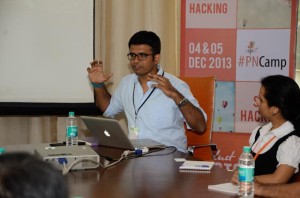
- Do experiments with an open mind. Design the experiment to validate your assumption rather than just reinforce your bias. Savor any surprise findings from your experiments as that new knowledge will help you make better judgments.
- Do all your experiments with your Minimal Viable Product (MVP). You can add scalability, security and other aspects after you have got a paying customer. A general rule of thumb is that it should not take more than 3-5 months to validate your assumptions.
- There are different kinds of MVPs with varying fidelities that will help validating your assumptions.
- Customer interviews and surveys. Low fidelity. This might help in validating the problem, but it does not validate your solution.
- Landing page on your website + traffic driven using Google adwords. Also low fidelity, but helps in validating the problem and that people are looking for solutions.
- Concept videos. Similar fidelity to landing page.
- Paper sketch. A little more fidelity as now prospects can see how you are planning to solve the problem.
- Digital wireframes. More fidelity as they can visualize how your solution might be and whether it is of value to them.
- Concierge MVP or Fake-O-Backend. High fidelity. This is where you manually process the customer requirements without putting any code or systems in place. But the customer is able to use your service to solve his problem.
- Working prototype. High fidelity. Immediate feedback on whether your solution solves their problem.
- The product itself. Highest fidelity. Typically, MVPs should not have this level of fidelity.
- The cost of change (a.k.a pivot) increases exponentially as the product goes through idea, prototype and launch stages. Also, the emotional commitment increases at each stage which makes it much more difficult to make those changes. So try to make any changes as early as possible.
- Do not make large investments without validating your assumptions. Among your assumptions, pick the ‘leap-of-faith’ assumption which is most important and validate it first. If the ‘leap-of-faith’ assumption fails, everything else fails.
- If you are in the business of ‘marketplace’, you need to validate your assumptions from both the suppliers and the consumers. Validate the supplier side assumptions first as they are the ones who will be making money in the marketplace. If you cannot validate supply side assumptions, there is no need to validate consumer side assumptions.
- First do the value experiments to figure out if there is a real need your product is solving. Once you have figured out that you are building something that some is willing to pay for, then run pricing experiments to figure out the right price for your product. Pricing experiments can also be done using A/B testing. For different sets of users, try different price points to figure out what price you want to finally decide. Simplicity is generally a very good thing, particularly in pricing models.
- Ideally, get an advance purchase order or a letter of intent (LOI) before writing any code. This also validates that you have found a buyer. Sometimes, we might a ‘user’, but that person may not have the buying authority. In those cases, you might be building something that is difficult to sell. It is better to sort out ‘who is the buyer’ assumption as early as possible.
- For startups, it might be sometimes difficult to get an advance purchase order. In those cases, validate the buyer assumption by seeking non-monetary commitment from the customer. For example, if a pilot needs to be done, the customer might be able to offer you accommodation and food in their guest house and also commit the time of some of his employees.
- Focus on one BIG problem at a time. For example, do not try to solve a BIG technical problem and a BIG sales problem at the same time. Focus on doing a few things well, instead of doing a lot of things.
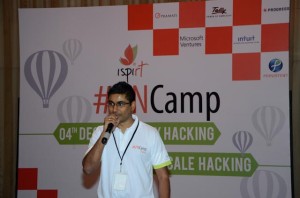
- Make it very painless for the user to give you feedback. This is the most valuable thing during ‘Discovery’ stage. Use this feedback and iterate.
- Always have a way for the customer to get a free trial. There is no substitute to the user actually using the product to validate your assumptions. And reduce the friction to trial as much as you can. Make it as easy as possible and don’t make the user think or read. Case studies, videos etc. help. But they will not buy till they experience the product.
- If your offering is a service (as opposed to a standalone product), do not give it for free. If people do not want to pay for a service, it means the need is not important enough.
- Till such time that you have found the product-market fit and have got paying customers, do not hire a sales person. Hiring sales people is a scale problem, not a discovery problem.
- It is usually good if your product idea comes to you because you are facing the problem yourself. This accelerates the validation of your assumptions and reduces the risk of making mistakes.
- Customers will buy the product if it solves their problem, not because you are good at selling. The product should be able to sell despite a poor sales experience.
- Getting the target customer right is very important. Avlesh Singh of WebEngage initially felt that engineers were his customers as it would automate work for them and keep the marketing guys at bay. But he realized that engineers were not buyers. They didn’t have the budgets or business reasons or the willingness to buy their product. However, the marketing folks were really interested in their product at it solved their business need. They also had the budget and they could see return on investment. It would also make them less dependent on their internal engineering teams. Pivoting the customer segment from ‘Developers’ to ‘Marketers’ was a major turning point in WebEngage’s journey.
- Pricing model should be based on customer’s perceived value, not on some technical aspect. For example, instead of charging for number of HTTP requests, it might be better to charge based on number of surveys completed.
- Derive your price based on market dynamics (current manual cost or pricing of competition) and not on your incurred costs. Build some differentiation in your offering and use that for price arbitrage.
- For techie founders, one thing that needs particular attention is that techies are highly opinionated and look at things in black and white. We need to get over our strong views. One way to achieve this is by meeting and talking to different kinds of people and getting their perspectives.
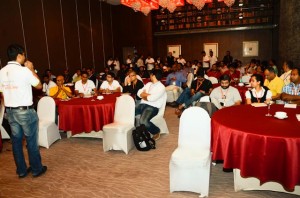
- By writing good content on your blog site, you can attract customers and establish thought leadership. If a person spends 8 to 10 minutes on your web-site, it is very likely that he will sign up for your free trial.
- Quora is a very good forum to attract customers. Provide genuine answers without shamelessly promoting your product. People hate it and you can also get blocked on Quora for directly promoting your product. One tip is to include your product name in your Quora user name – that way when people see your name, they see the name of your product too.
- What works for some other company might not work for you in your context. There are several factors at play and it is difficult to figure out. The only way is to run various experiments and see what works.
- Think in terms of how the end user is going to use your product. The human element is very important. You must know your user well – really really well. Know the context in which the user is going to use the product – the user’s demographic, life style, social life, aspirations, work life schedule, how they work, and their aspirations. Create personas of the users. There are free templates available online to create target personas.
- Feedback from users should shape the product. It is common to see several bug fixes or new features between version to version. But rarely do we focus on customer delight as the focus of a release. Customer delight should get more priority than new features.
- You must observe how the user uses the product to get a deeper understanding. If you ask customers pointed questions, they will give pointed answers and hence it is not very valuable. Engineering, business development, product mgmt and UI teams should all experience first-hand how the user uses the product.
- Never ask customer what they need – instead observe what they do.
- Never ask for their feedback – instead watch them use it.
- Never just listen to what they say – instead observe their behaviour.
- There are free tools for capturing the user behaviour. They help you record the user experience through a web cam when they are using the product. Search for them online and evaluate for yourself.
- Sign up folks from your target segment. Call 5 folks on a Saturday and observe their behaviour with the product.
- Be frugal and save money. Do not splurge during initial days.
- Startup people have to be hands-on. Should be ready to roll up the sleeves and do all kinds of work.
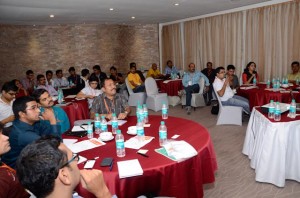
- You have to persevere. You will hear a hundred “No”s before your first “Yes”. Tip: People seldom refuse a cup of coffee. Ask for that small coffee meeting. If the customer sees value in your offering, he will give you more time.
- Hiring good people is good. If they are good hearted, better. Focus on getting a team that can run as fast as or faster than you.
- Luck is more important than competence. Competence is a must, but you need luck also to be successful. There are several factors which are not in your control but can have a major impact on the outcome of your company. However, you must run like the devil is behind you and not just wait for lady luck. When a lucky event happens, you must analyze it to figure out why the lucky event happened.
- Sales, product management and engineering are three important pillars of a startup. Ensure you have specific individuals who are tasked with each responsibility. The same person can play multiple roles, but you must be clear on who is playing which role.
- You must qualify the companies/individuals who will be suitable for your product. Not everyone is going to be your customer.
Scale Hacking:
- Scale hacking is all about aligning and finding the business model after getting the product-market fit. The key to scale hacking is to find out what is working and do more of it.
- Initial sales happen because of the founder’s passion. Sales people need a template for selling.
- If you have a lousy product, nobody can sell it. The product should be great and the positioning should be right. Folks should be willing to buy it in spite of the sales experience.
- There is no template for scaling. You need to explore different avenues and channels. Some of them will work for you and some of them won’t. Even when some are working, you should be exploring new channels as you might be missing out a very good revenue source.
- You need aim to be in the top 3 players in your market if you desire to scale. You first have to be a player on par with competition.
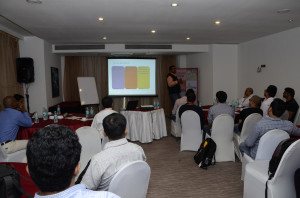
- You might have to change your sales pitch multiple number of times based on reaction from the market.
- When the customer can visualize the benefits of your product, it makes a huge difference. E.g. if you say that the user can jog after taking your medicine – it can be visualized by the customer and have a bigger impact than just saying it will make you healthy. Visuals are very important (good graphics). Do not expect the customers to extrapolate mentally.
- You have to show customers the solution to their problem. For example, freshdesk creates a site called customer.freshdesk.com and puts their logo there so the customer can see how the solution will look like. Also, they show role based dashboards based on who they are giving the demo to. Different people like to see different things and you need to customize your demo to how it will help them.
- Marketplaces are something you should definitely consider for scale hacking. E.g. Google app store.
- Integrations are the new SAAS channel. E.g. integrate with salesforce, basecamp etc. Then write a blog on how the integration works. Write to the business person at the Salesforce side and ask them also to promote your integration. Typically, they are also interested in promoting something that promotes their product.
- Positioning is very important in the mind of the customer. For example, though Freshdesk does several things – the core positioning is that it is a customer support solution. For example, they provide invoicing, chat, time sheet also, but they do not position them as separate products – it is all under the umbrella of customer support.
- Unassisted buying (e.g. purchase directly from the website) can get you only small tickets. If commitment is higher, customers need to talk to a live person and you need to invest in field sales.
- Importing from competition is a 1.0 feature. Do not postpone it thinking it is not your core work. From customer’s point of view, it is very important to have his current data migrated over to your product. Otherwise, they may not even bother to try your product. Make it very easy for your customers to come over to your solution.
- Customer’s attention span is very small. He might sign up for your product, but forget about it. For example, a customer might provide his email id and sign up, but might not even bother to go to his Inbox to click on the verify link. Hence, engaging leads is very important and focus your energies on getting them to trial your product.
- Nobody likes to talk to a sales guy. Have a title like ‘account manager’ etc. and this person says that he is trying to help out with the evaluation.
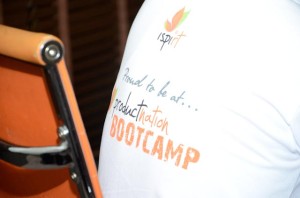
- Webinars are very effective for scale hacking. Offer a free webinar on a related topic and soft sell. There has to be enough meat in the webinar content itself which will be attractive and worthwhile for the attendee. In webinars, people do not want to hear your pitch. They want to see thought leadership and practical advice for them. If you can, have customers speak at your webinars. This is better than someone from your company speaking. For example, the title of a webinar can be ‘CMO of company X speaks on how to maximize ROI on Y’.
- Once you start scaling, you must have support staff available in the time zone of the customer. This is very important due to global competition. In India, companies have different shifts of support personnel working from India but during the business hours of the customer’s time zone.
- Pricing is a challenge. You should look at the current cost for the customer, price charged by competition and come up with your own pricing. If it is too high, it scares customers away and if it is too low, you end up leaving money on the table. But this problem is unsolvable. You can only do price experiments to figure out the price of your product in the market.
- ShopSocially moved to small monthly subscription + cost per social action. This way they have a very low entry cost for the customer and as the customer uses more of their product, they will pay more.
- Try to get a marquee customer in your portfolio. It will have a huge impact on your credibility and growth. Suddenly, prospective customers will look at you in a very positive way. So you need to be flexible on pricing during the initial days. Give discounts in exchange for case studies and testimonials. Or give discounts over larger timeframes. E.g. 3 months free if they purchase a 1 year license.
- Evaluating a sales person is tricky, unlike an engineer where the results can be directly attributed to the efforts. Tip: Shadow your new sales hire for 3 months to judge for yourself if is good for your business. If there is a mismatch, let go of the sales guy as early as possible. Otherwise, the cost to your business is huge.
- Always collect data on how people are using your product, which features they are using and which they are not. This should be one of the main ingredients for product direction decisions. If the product manager is sitting in a cube, then it is not good. He should be talking face to face with customers and getting real world feedback.
- When you are trying to move customers away from a competitor who they have already purchased, you need to protect the customer’s investment so far. E.g. when a customer had 6 month license still left with your competition, you should offer 6 months free on your product to protect their investment. However, see if you can have the customer pay for the first month and then the next 6 months given free. This ensures that they are serious about switching to your product and have made a commitment to you.
- If you are in a commodity market where there are hundreds of competitors, then execution is the key differentiating factor. Of course, it goes without saying that the product has to be very good. If you are in a niche market, then value proposition is more important than execution. You might not have the best quality and completeness of the product, but if there is not much competition, then you should focus on the value proposition more than the execution of completeness.
- Think hard on how you can leverage your happy customers. Ask for referrals. At every sale, try to leverage. Ask your referrals to write guest blogs on your site, case studies and testimonials. Photo testimonials are better than just text as they are more credible.
- Leverage influencers. They can tweet about you. Follow influencers and include them with @X so they will notice you. Try to get them to follow you. Share signups and success stories through social media. As the company grows, you need one person dedicated for social media and working with influencers, establishing connections etc. Bear in mind that influencers love praise. It also helps if you can get thought leaders from academia writing about you.
- Write thought leadership articles and blogs – maybe twice a month.
- When you sign up a customer in a vertical, find out the competitors in their space and try to make them your customers. Folks pay more attention if they know their competition is using your product.
- Set up Google Alerts on keywords so you get notified of new stuff. Then go there and leave your comments. Mention.me is another site similar to Google alerts.
- LinkedIn groups is a good source of leads. Answer questions there. Also post questions yourselves on challenges in your domain.
- There are tools like pardot, marketo, data.com for follow-ups. Use them if you see the ROI on them.
- Conferences are not so great from a lead generation point of view. But they are good for showing your presence in the market place.
- Don’t innovate on the business model, particularly when you are a startup. Go with tried and tested ones. Select the right sales model for your product depending on the kind of product and price of the product. Look at how your competition is doing it. Usually, it is better to follow their model during the initial days and then experiment later.
- A recommended reading for all startups is “Most startups should be deer hunters”. Essentially, there are three types of customers – elephant, deer and rabbit. Catching elephants is very tough until you are of certain size. Catching rabbits is very tough to survive as they are spread too thin and even if you catch one, you get only very little meat. Hence try to catch deer – which are right sized for you.
- For cheaply priced products, educational institutions are a good place for doing pilots and getting feedback.

- In scale hacking, have a good sense of metrics on customer conversions. How much revenue is being generated, from how many customers, out of how many evaluations, out of how many leads, out of how many visitors? Measure, track and improve the rate of conversion at each stage of the funnel.
- Once you have had success with your first product, you should consider other products for scale hacking. Build newer revenue streams based on the incoming cash of existing successful products
- Hiring cross-continent is a very big leap-of-faith for an entrepreneur. You need to be very careful with the first set of people you hire in a different geography. Culture alignment is key to global success.
- Taking funding for scaling is a very good idea. Investor money is like rocket fuel. You can either go up or fall down fast. You can go from ‘darling’ to ‘donkey’ quite fast with VC money.
- All news is good news when you are small. So don’t shy away from publicity of any form. Of course, do only those things that you are comfortable doing.
- Requirements should be driven by customers, where ever possible, instead of internally imagining and creating requirements which might not be of any value to your customers. When a sales person gives a requirement, ask ‘why do we need this and how will it help’ five times. If you can find a good answer, then the requirement is a real need.
- When deciding on which new requirement should be added to the product – consider the return on investment. This is commonly overlooked. Usually, the latest incoming requirement is given more importance at the cost of an older one. Have a methodology for choosing requirements – based on factors such as number of customers requesting the requirement, the ROI that the sales team believes this will generate and if the sales team is willing to stick out its neck for this requirement. Always use data to make product decisions.
- During scale hacking phase, ensure you have continuous customer feedback. Have a customer advisory board of your key customers and have a relationship manager who works closely with these customers. Get their inputs on new features you are planning to build. Having a good relationship with them also helps you know the pulse of the market, get inputs on competition and getting strong case studies and testimonials. Meet with key customers periodically.
- Channels are extremely important for scaling. Be clear on how the channel can make money off of you. Partners should benefit because of you. Either directly by making money or leading to sales of something else. For example, in non-SAAS products, system integrators make money by implementation, customization and support.
- Partnerships are for successful products. That way the partner can sell easily. They want a winning product. If the product is new and complex and it has a long sales cycle – partnerships might not be of use to you.
- Partners can help you enter large enterprises as they are already on the vendor list. They can ‘white label’ your offering. Getting on to the authorized vendor list of large companies is itself a very complex and time consuming process.
- Consider partnering with frameworks – e.g. building an add-on to an existing framework which has a good marketplace. That way, your discovery problem is solved to a great extent. Many companies die because they struggle to reach their prospective customers.
- In SAAS kind of offering, traditional partnerships do not work as the partner does not make good money upfront. They do not want to wait for a long time to reap the rewards. SAAS partner ecosystem is not there yet.
- Partnering with platform players like Microsoft, SAP, Oracle is a good idea in principle. But even there, promoting a startup’s product is not easy. They have very high qualifying factors for them to select your product for promotion. For example, you need to already have thousands of users. Partnering with platform players is a great strategy for scale hacking once you have a critical mass of users.
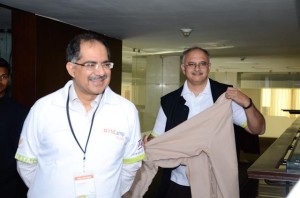
- Engineer driven products are typically not so great in user experience. It might be worthwhile to hire/outsource to a UX expert. These days, coolness of UI is a very important factor.
- Mobile centric or mobile first is a very sound strategy for growth. It is easier to find early adopters.
Conclusion
I hope that at least some of the 101 takeaways provided new data points in your startup journey. While there is no silver bullet and each startup has to go through its unique journey, there are several common themes that are generally applicable. And we can learn from those who have trodden the path before us.
Many thanks to iSPIRT and all the volunteers and facilitators of the Product Nation Boot Camp for this wonderful initiative.


